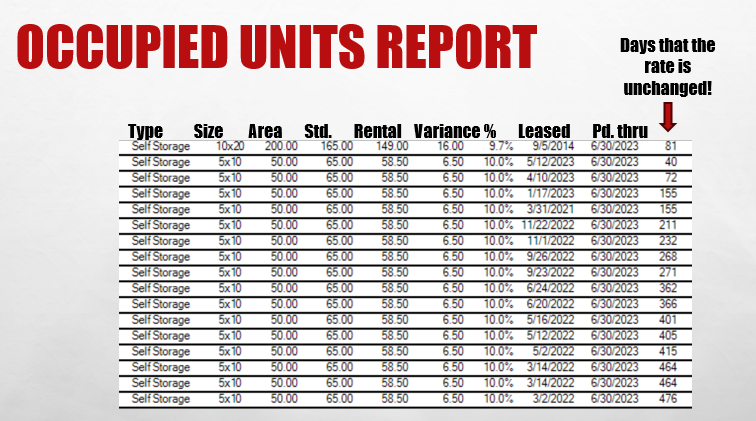Customer Service, Management, Operations, Self-Storage
Falling Occupancy – What Can You Do?
In a changing economy, it is essential to remain calm. Even if your numbers are decreasing and you are not reaching 100% occupancy, we are still in the high nineties. It is crucial to consider what we can do differently, especially during these more challenging times.
How Are Your Competitors Doing?
To begin, conduct a rate survey of all your close competitors. Check their websites for pricing information, but also remember to call them directly, as prices may vary. Look into the sizes of storage units they have available and identify which ones are currently out of stock. This information will help you determine your pricing strategy. You can also utilize software like Yardi Matrix to gather up-to-date industry data.
Additionally, inquire about any additional fees your competitors may charge and explore what other services they offer. Understanding your competitors is crucial, whether you are new to the self-storage industry or already familiar with it. It is essential to stay informed about what they are doing to position your services effectively.
Know Your Management Summary Numbers
When comparing your rates with those of your competition, it’s also essential to review your management summary and the numbers related to your storage property. This way, you can identify areas for improvement and understand your falling occupancy.
To begin, I’ll help you analyze customer rates and show you how to gather relevant data, including the duration of time customers have been at their current rates. For instance, it’s crucial to understand the insights provided in your management summary. You’ll find information such as gross potential rates, unrentable unit rates, and occupied unit rates (see example below).

Suppose your store reports a gross occupied unit rate of 98.7%. However, the actual occupied unit rate is only 86%. If you factor in concessions, the effective occupancy drops to 84%, which we can refer to as the economic occupancy.
While the manager might claim that the store is operating at 98.7% physical occupancy, the reality is that you’re generating revenue as if the occupancy were only 84.8%. This discrepancy is a concern. It’s vital to understand what accurate occupancy means, as the economic occupancy figure provides a more accurate reflection of your revenue potential. The concessions you offer may be negatively impacting your overall occupancy, and this is an area worth exploring in more detail.
Yes, You May Need to Increase Your Rates
It’s all about keeping the rates high, and one way to achieve that is by increasing them. I like to pull an occupied unit report and analyze the number of days since the rate last changed. For instance, in the example below, the first unit listed has gone 81 days without a rate adjustment, which isn’t too concerning. However, at the bottom, there are units that have maintained the same rate for over 400 days—more than a year. For those, I would suggest bumping the rates up to a higher level. This adjustment can positively impact your overall numbers.

While I’m not concerned about 81 days, it’s essential to consider that some companies are becoming increasingly aggressive with rate increases, particularly for existing tenants. When raising rates, it’s crucial to avoid small increases, like just a dollar. Instead, consider making increases of $5, $10, or even more, depending on the situation. I’ve implemented rent increases of $40 or $50 before, based on the cost of the space itself.
Optimize Your Revenue
Let’s discuss the topic of increasing rates, particularly for customers who are currently paying below the market rate. When you approach this situation, it’s essential to focus on managing the asset effectively. It shouldn’t matter if a customer is a frequent visitor, has multiple units, or is exceptionally lovely. The crucial aspect is ensuring that you are optimizing your revenue.
Make it a habit to assess your customer rates regularly. Some of you may do this every 90 days, while others may look at it annually; however, I believe waiting a whole year may be too long. In today’s market, it’s reasonable to be more proactive with rate increases, even if the increase is only a few dollars.
Reduce Delinquency
Another critical issue to address is delinquency reduction. Make it a priority to reach out to customers with overdue payments via phone calls and emails, and actively work to resolve these delinquencies. Recently, I observed storage properties in California that had customers in delinquency for six or seven months before the accounts were auctioned. That is too long. Adhere to your established processes and protocols for managing these situations. If customers don’t pay within the designated timeframe, don’t allow their accounts to linger indefinitely, as it only makes recovery more challenging.
Making Capital Improvements? Time to Raise Rates.
Additionally, it’s wise to consider raising prices for customers who have occupied a space for over a year without any increase. This is especially true if you are investing in capital improvements at your facility, such as installing a new gate, refurbishing doors, or repaving. Implementing rent increases during these improvements demonstrates to customers that you are enhancing their experience. For example, malfunctioning gates or poor security can frustrate customers, so addressing these issues while making rate adjustments can help justify the increase.
Move Customers to Smaller Units
Remember, you can consistently offer to move a customer to a smaller storage unit. Often, when I assess spaces—especially when preparing for an auction—I realize that many customers could have fit their items into a unit half the size of what they’re currently using. If they had chosen the correct size from the beginning, they might not even have had to go to auction.
If a customer is in a bind, suggest the smallest possible unit. We never try to upsell because, more often than not, we make more money per square foot on smaller units compared to larger ones. It makes sense for us to encourage customers to choose the smallest space that meets their needs, unless we only have larger units available, which leaves us with fewer options.
Don’t Forget…Treat Your Customers as Guests
Another important aspect is how you treat customers. It’s vital to treat them like guests, going above and beyond what is expected. For instance, I love that we have a coffee station with a Keurig and cold water available. Exceptional service makes a big difference. Recently, my son visited a site in Phoenix, and he was impressed by the manager’s friendliness. From the moment he walked in, she greeted him with a smile, took the time to show him the space and another option, and kept everything clean. She even made a real connection with him before he left by providing him with helpful information.
Being warm and conversational can significantly impact the customer experience. Even if you charge a bit more, people appreciate those little extras. They understand that the difference between your facility and a less maintained one is often just a few dollars. People are willing to pay a little more for a place that is clean and well-managed.


